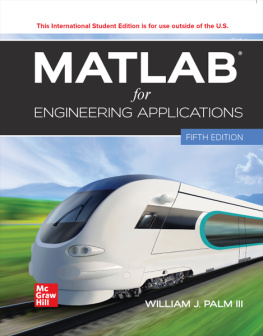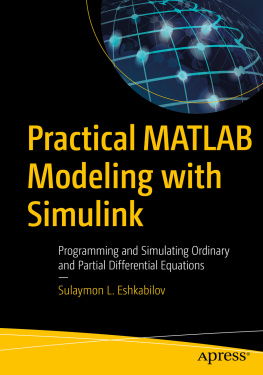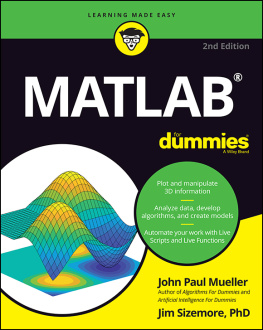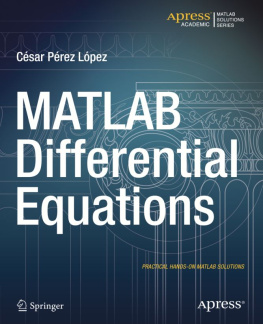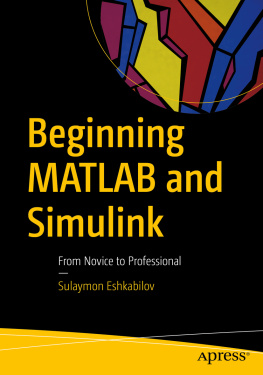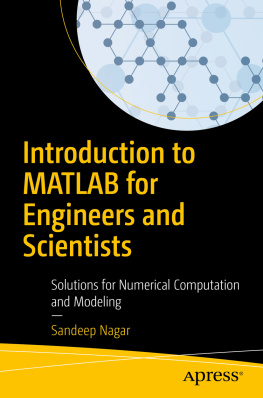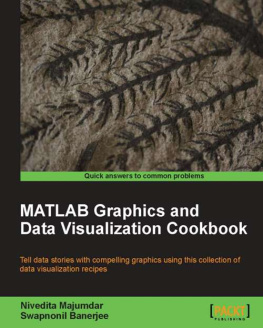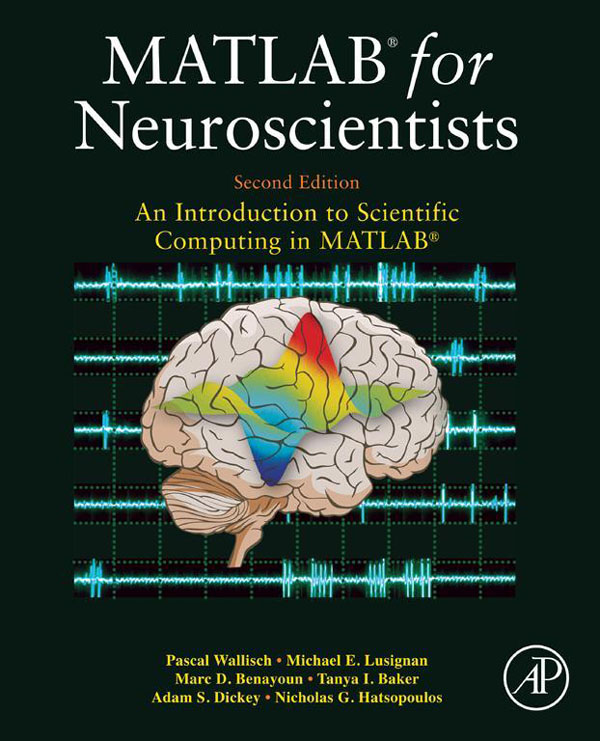Michael E. Lusignan
Marc D. Benayoun
Tanya I. Baker
Adam S. Dickey
Nicholas G. Hatsopoulos
Copyright
Academic Press is an imprint of Elsevier
32 Jamestown Road, London NW1 7BY, UK
225 Wyman Street, Waltham, MA 02451, USA
525 B Street, Suite 1800, San Diego, CA 92101-4495, USA
Copyright 2014, 2009 Elsevier Inc. All rights reserved
MATLAB is a trademark of The MathWorks, Inc. and is used with permission. The MathWorks does not warrant the accuracy of the text or exercises in this book. This books use or discussion of MATLAB software or related products does not constitute endorsement or sponsorship by The MathWorks of a particular pedagogical approach or particular use of the MATLAB software.
No part of this publication may be reproduced, stored in a retrieval system or transmitted in any form or by any means electronic, mechanical, photocopying, recording or otherwise without the prior written permission of the publisher.
Permissions may be sought directly from Elseviers Science & Technology Rights Department in Oxford, UK: phone (+44) (0) 1865 843830; fax (+44) (0) 1865 853333; email: for further information.
Notice
No responsibility is assumed by the publisher for any injury and/or damage to persons or property as a matter of products liability, negligence or otherwise, or from any use or operation of any methods, products, instructions or ideas contained in the material herein. Because of rapid advances in the medical sciences, in particular, independent verification of diagnoses and drug dosages should be made.
British Library Cataloguing-in-Publication Data
A catalogue record for this book is available from the British Library
Library of Congress Cataloging-in-Publication Data
A catalog record for this book is available from the Library of Congress
ISBN: 978-0-12-383836-0
For information on all Academic Press publications visit our website at elsevierdirect.com
Typeset by MPS Limited, Chennai, India www.adi-mps.com
Printed and bound in United States of America
14 15 16 17 10 9 8 7 6 5 4 3 2 1

Preface to the Second Edition
The publication of the first edition of MATLAB for Neuroscientists was met with a reception that far exceeded our expectations, vindicating our intuition that there was an urgent need for such a text. Cynical voices often suggest that a new edition of a textbook is primarily designed to enrich the publisher. Not so in this case. While the first edition was widely adopted as a textbook as well as by individual students and investigators, several developments made it prudent to consider a second edition. First, neuroscience itself has changed, e.g., there is now an increased interest in the exploration of LFP signals. Second, MATLAB has evolved, e.g., through the introduction of parallel computing environments. Finally, and most importantly, we received copious feedback in response to the first edition. For example, there was an overwhelming consensus that the book would benefit from an increased number of basic tutorials in the front matter. Taken together, all of this suggested to us that it might be time for an update. Deciding to release a second edition afforded us the opportunity to address these issues, and also to improve upon the first version in other ways. For instance, we were now able to introduce full-color figures throughout the book, something which we think will improve its usability considerably, given that data visualization is one of MATLABs greatest strengths.
One thing that has not changed in the second edition is our philosophy of and focus on trying to foster behavioral change. Unless a book somehow leads to a change in behavior (that is, the way you go about doing things), it is very likely that you will forget what you read. We know; it happened to us countless times. Sometimes, the only thing one remembers about a book is that one read it, but nothing else. Thats not what this book is about. This book is about creating lasting behavioral change, specifically allowing you to use MATLAB more effectively, which in turn will (hopefully) make your research more productive. This requires more than just reading. It requires interaction with the content on a deep level. Thus, we tried to frame the content of this book to maximize the probability of meaningful engagement with the material.
The unbroken popularity of MATLAB among the neurosciences underscores the need for an accessible and up-to-date guide to its use. We hope that we succeeded in our intention to fulfill this need.
Many people helped us in our attempt to do so, and we thank them here. In addition to all the people we thanked in the first edition (on which this second edition is based), we also would like to thank April Graham, Mica Haley, Melissa Walker, and Greg Harris as well as Caroline Johnson and Melinda Rankin for their almost inexhaustible patience, kindness, and support; Donald McLaren for helping us with the neuroimaging chapter; and Qian Cheng for educational advice.
Finally, we alsoand in particularwould like to thank our students and colleagues for feedback on the first edition. In a sense, experts are the last people who should write a book like this. By their very experthood, they are often incapable of appreciating what would be helpful to someone who is not an expert and is just beginning to build cognitive structures in this domain. Therefore, feedback is absolutely crucial to give the experts information on how to make these materials more accessible to nonexperts. In a sense, writing a book like this teaches the authorsthrough feedbackhow to write a book like this. And thus, the circle is complete.
The authors
Preface to the First Edition
I hear and I forget.
I see and I remember.
I do and I understand.
Confucius
The creation of this book stems from a set of courses offered over the past several years in quantitative neuroscience, particularly within the graduate program in computational neuroscience at the University of Chicago. This program started in 2001 and is one of the few programs focused on computational neuroscience with a complete curriculum including courses in cellular, systems, behavioral, and cognitive neuroscience; neuronal modeling; and mathematical foundations in computational neuroscience. Many of these courses include not only lectures but also lab sessions in which students get hands-on experience using the MATLAB software to solve various neuroscientific problems.
The content of our book is oriented along the philosophy of using MATLAB as a comprehensive platform that spans the entire cycle of experimental neuroscience: stimulus generation, data collection and experimental control, data analysis, and finally data modeling. We realize that this approach is not universally followed. Quite a number of labs use differentand specializedsoftware for stimulus generation, data collection, data analysis, and data modeling, respectively. Although this alternative is a feasible strategy, it does introduce a number of problems: namely, the need to convert data between different platforms and formats and to keep up with a wide range of software packages as well as the need to learn ever-new specialized home-cooked local software when entering a new lab. As we have realized in our own professional life as scientists, these obstacles can be far from trivial, constitute a significant detriment to productivity and are the root cause of many a conniption.


